Glass Roots: A Tile Artist Shares His Story
By Jimmy Reed
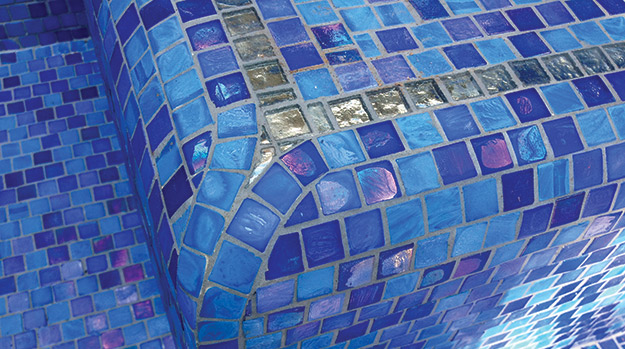
As both an artist and owner of Rock Solid Tile, Jimmy Reed’s passion for working with glass tile is as compelling as the challenges and possible pitfalls are sobering. Here he pulls back the curtain to reveal the thought processes and professional values required for achieving “rock solid” results when using one the industry’s most exquisite materials.
Make the right choices in material and design and you can generate works of art that will last for decades, if not longer. Miss the mark and the work is probably destined to be an expensive eyesore.
In other words, working with glass tile is not for the novice or faint of heart. It’s a high stakes game that can challenge you physically and intellectually — which is all part of why I love it so much.
PRECISE DISCIPLINE
The need for sealers is driven by the nature of stone itself: Although most types appear hard and impervious, many are actually quite porous and, left unprotected, are susceptible to freeze damage, staining and decay.
A great deal has been written and said about the beauty of glass tile mosaics in pools and other settings. I could join that chorus of voices with my own feelings about this amazing material, but rather than echo sentiments that have become a familiar refrain for many, I’ll stick to a more practical discussion.
Those practicalities start with the fact that glass tile changes the way we think about tile surfaces. The spectrum of products and level of technical knowledge necessary for top-shelf results has pushed our expertise and capability — these days we act as design consultants as much as tile installers.
One of the reasons behind that evolution is the nature of the material itself. Glass tile requires extremely precise surfaces and dimensions for the concrete shell. In projects where we’re on board at the start, we’re able to work with builders to establish precise criteria for contours and dimensions. These are far more rigorous than what you run into when a pool is surfaced with traditional plaster or pebble surfaces, which cover imperfections in the pool shell.
By contrast, glass tile, and really all types of tile to some extent, will not hide flaws, but instead reveal them. That’s why it’s extremely helpful when builders recognize that fact from the start and work to what is basically a zero-tolerance standard. In situations where we come on the scene when the pool’s already built to less precise tolerances, we must go to great lengths when “floating” the substrate to create the requisite level of precision. We don’t place a single piece of tile until we’re certain the dimensions are dead on.
While that demand for precision certainly speaks to the “craft” side of the business, the material drives the more artistic decisions. That’s where both communication with the homeowner and product knowledge come into play.
Because glass tile is far and away the most expensive type of pool surface, homeowners often come to the process with extremely high expectations and frequently have their own ideas about the look they’re seeking.
Perhaps the most emotional of all issues when discussing options is color. The options are kaleidoscopic, which means you can make choices that are a hand-in-glove fit with the design of the pool, the home’s color palette and the surrounding landscape. It also means that sometimes clients are set on a color that’s completely wrong from a design standpoint.
For example, if we’re working on a project in a craftsman-style house, that style will likely dictate the use of subdued earth tones — greens, grays, creams or even black — that will complement the typically verdant setting. That’s not going to be a setting in which you’d want to use royal blue, as it would appear almost garish in contrast. But in a more classical setting, that same rich blue might be the best choice. It all depends on the situation.
We run into similar questions regarding the level of iridescence, texture and transparency. Those qualities are more subtle than color, but they can generate emotional responses from clients. Some homeowners might be mesmerized by the prismatic quality of particular product lines, while others will prefer a more opaque appearance. Some want the tile to jump up and make a strong statement, while others want it to serve a more retiring background role supporting the setting with color and reflection.
To better illustrate how these projects unfold in specific terms, let’s take a look at some of recent efforts.
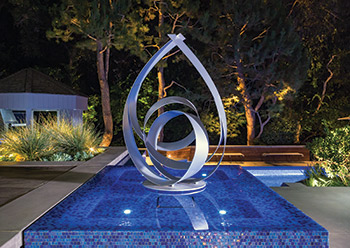
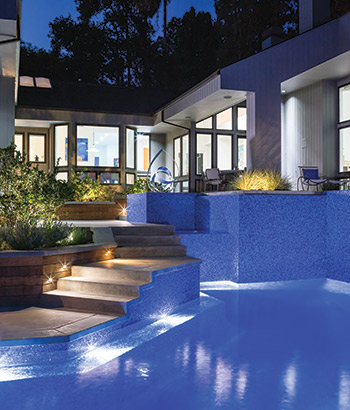
Team Power
Photos courtesy of Christian R. TerryThe client for this project called me and said she wanted a glass tile pool. When I showed up, there was an existing old pool with very little going on around it other than some brickwork and a block wall that was being installed. I asked her what she was looking for in terms of design and direction and she had no idea. All she knew was the she wanted some type of glass tile pool.
It was obvious the entire space needed much more than a glass tile pool surface, so I referred her to landscape architect Allison Terry and pool builder Dave Penton, both professionals I admire and respect. With those top-notch pros on board, the design work began in earnest and resulted in a tremendously complex installation.
Among the pool’s many design elements is a set of raised “cubes” near the house that spill into the pool below. As pictured, the cube on the right contains a perimeter overflow spa, a challenging and complex story unto itself. The center cube is a planter with the same overflow edge detail. The cube on the left contains a beautiful contemporary stainless steel sculpture and also flows into the pool via a fourth cube below the sculpture and planter trough with an overflow edge detail.
When looking at the pool from the house, each of those four areas looks like a sheet of glass flowing into the pool. It’s kind of a quad vanishing edge design on steroids, all very intricate and beautifully executed. The hydraulics were designed by Dave Peterson of Watershape Consulting.
As for the tile, the client wanted something that was vibrant and natural. We started out looking at blends of green tile, but the client felt that actually blended too well into the setting, which looks like you’re in a forest. She loves the ocean, so we started looking at different blue blends, which would be both soothing while providing a vivid contrast to all the natural greenery.
We wound up using a custom blend of four shades of blue from manufacturer Sicis (Ravenna, Italy).
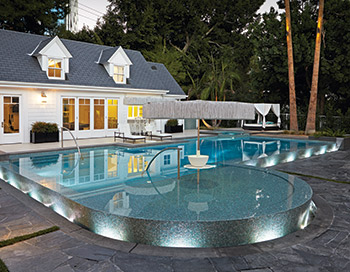
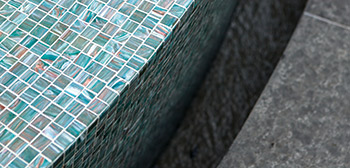
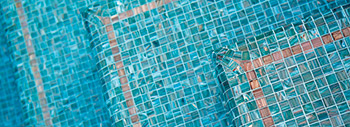
Beyond White
Photos courtesy of Douglas HillWe were brought into this project at the suggestion of Skip Phillips of Questar Pools, who did the design along with builder Dave Penton. The design was inspired by the client’s love of the art deco resort pools of Miami Beach.
At first the client wanted to use only white tile, the kind you might find at a swanky luxury commercial pool. However, while he was set on white, he wasn’t keen on having a pool that appears bright blue. As we know, optical physics dictates that water absorbs red and reflects blue, ergo, achieving a white-looking finish is nigh onto impossible.
That led master waterscape designer Skip Phillips to explore other colors until he lit upon this green/gray mosaic from Bisazza. In this case, we lightened the grout color to help define the mosaic instead of concealing it with grout that is closer in color.
This design also shows off the impact of water depth in the tile’s appearance. In the shallow end, the mosaic stands out, but in the deeper water closer to the house, the reflective qualities of the deep color take center stage.
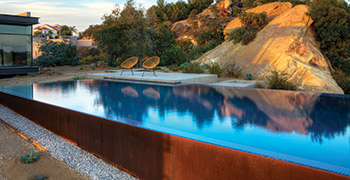
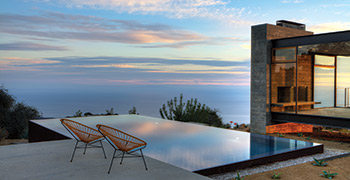
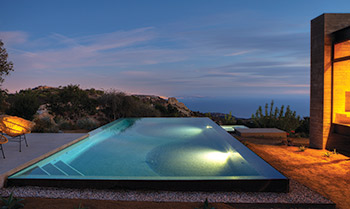
Modern Marvel
Photos courtesy of Douglas HillThis project was the work of builder/designer Paolo Benedetti, who is well known for these sorts of ultra-contemporary projects. The pool is a simple rectangle with a 360-degree perimeter overflow that blends perfectly with the stark architectural lines of the home.
The tile is a gray/blue color that supports reflections. The idea was to have the pool blend in with the ocean and the sky, which is different every day. In effect, the mosaic disappears. We looked at about a dozen different colors of grout. The homeowner ended up choosing a stock color because it closely matched the color of the tile.
Although simplistic visually, this pool acquires its elegance from the vanishing edge, the adjoining architecture, spectacular setting and, of course, the glass-tile finish.
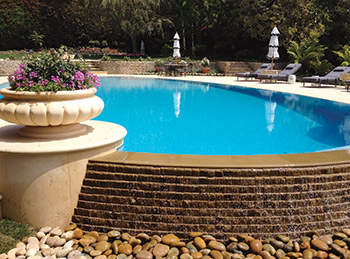
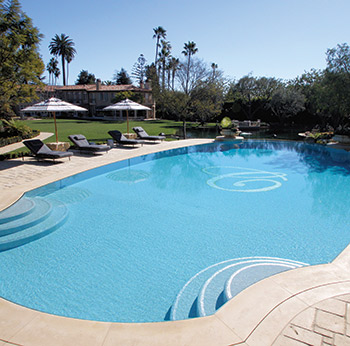
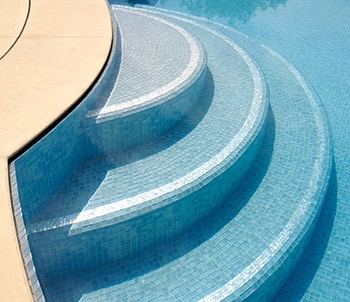
Grand Scale
Photos courtesy of Douglas HillThe homeowner for this project is an extremely wealthy commercial real estate developer who bought this property and three adjoining homes just so he could tear them down and create this massive backyard. It’s a truly opulent setting with a 30,000-square-foot main house.
The pool was a glass-tile pool from the get-go and we were fortunately brought on board at the very beginning when the pool was still in the steel and plumbing phase. We hadn’t worked with the builder, Triune, before, but they did a terrific job and paid close attention to the critical details.
Although relatively simple in its visual design, the pool was nonetheless tricky due to its precise oval-shaped knife-edge overflow detail and relatively massive size. It’s 60 feet long by 30 feet wide. The walls are perfectly plumb with a squared transition to the floor, which is perfectly level left-to-right and only pitches down slightly from the flat shallow end toward the deep end where it levels out again, creating a three-surface floor. There’s no continuous slope anywhere. The only curved transitions are leading edges between the risers and treads on the steps.
The tile finish is an exercise in elegant simplicity. It’s a very light blue mosaic from Bisazza with the letter “C” mosaic rendered in white gold tile bordered by gold. The tread markers on the two wedding cake step entries are also white gold.
The tile detail on the perimeter overflow is critical.
To create it, we used a mitered edge and brought the vertical inside tile up to the top of the edge, mitered the tile on the trough side and polished it to create a precise transition.
